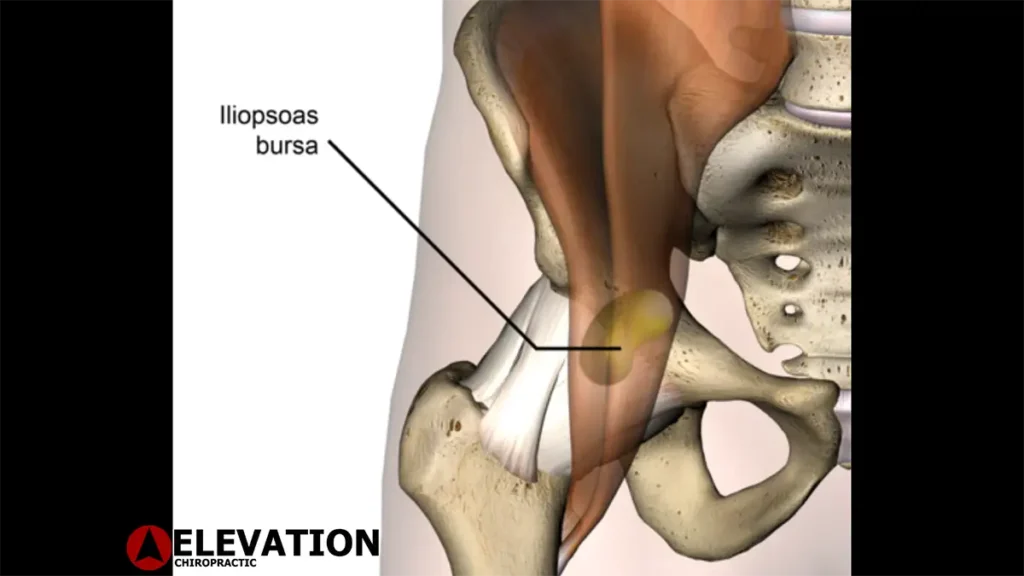Getting to the Root of Hip Pain: A Rowlett Texas Chiropractor’s Perspective
What is Hip Pain?
Stiffness, pain and immobility are the most common symptoms of hip pain complaints. Often, the inguinal region (groin) is the part of the body which can transfer pain to the upper leg or the knee. Due to pain and a limitation of movement in the hip, we can often see pain avoiding movements. This puts more pressure on the joints which can lead to inflammation of the bursa. (Bursae are small, jelly-like sacs that are located throughout the body, including around the shoulder, elbow, hip, knee, and heels.) These bursae contain a small amount of fluid, and are positioned between bones and soft tissues, acting as cushions to help reduce friction. When the iliopsoas bursa becomes inflamed, this will cause the body to signal something is off and it communicates this through pain.

Your hip is a very stable and strong joint. It’s known as a ball-and-socket joint. This is because the top of the thigh bone is shaped like a ball. This ‘ball’ sits inside a hollow socket in your pelvis. Ball-and-socket joints give the most movement of all the different types of joints in the body. The hip joint is held together by a covering of muscles which are secured to the bones by strong cords called tendons. Understanding the anatomy of the hip is important to understanding your unique pain and the healing process.
If there is a problem with your hip joint you may feel pain in the groin, down the front of the leg and in the knee. Sometimes knee pain is the only sign of a hip problem – this is called referred pain or radiated pain. You may feel pain on the outside of your hip or in your buttock – though this can also be caused by problems with your lower back.
Hip Pain or SI Joint Pain?
When patients describe to us or point out their hip pain, a majority of them point to the place where the pelvis (ilium) and sacrum (lowest part of the spine above the tailbone) meet. This is called the sacroiliac (or SI) joint. This joint transfers weight and forces between your upper body and legs. It is an essential component for energy transfer between the legs and the torso.
Because the SI joint is connected to the nerves that run to your bowels, bladder, and reproductive system; you may also experience symptoms of and relating to those areas.
How Did This Hip Pain Start?
The muscles, tendons, cartilage, ligaments, and nerves of and around the hip can become aggravated or inflamed by many things and, most of the time, there is an explanation for the pain – repetition, overuse, misalignment, arthritis, or subluxations in the L4 or L5 vertebrae above the sacrum are all common causes of hip pain.
Will This Pain Go Away On Its Own?
Our bodies are VERY adaptive, but this may result in a ripple effect of other issues. We use our hips for so many different movements, it can be frustrating when the pain is not going away. Whether the problem has existed for a while or just occured, it is vital to be proactive in responding to your body’s signals and helping it heal. Although the hip is a very strong and stable joint, our first recommendation is getting the low back and pelvis checked as it is very important in the function of the hip. These bones can shift very easily and if something is out of alignment and not addressed, it may cause long-term damage to the nerves.
Treating Hip Pain with Elevation Chiropractic
After assessing the hip pain complaints of a patient, a chiropractor will examine the mobility, biomechanics, muscles, tendons, and spinal nerve function. With this briefing of the moving parts of the body, chiropractors will use their expertise to determine the primary cause of the complaint. The low back will get extra attention because many hip symptoms are a result of problems in the lumbar (L1-L5 vertebrae) or in the sacrum (S1-S5). In addition to a mobility assessment, X-rays may be needed to look at the structure of the spine and to pinpoint any subluxations.
At Elevation Chiropractic, our treatment plan consists of a combination of proactive and reactive care. This is done by:
- Manually adjusting specific areas of the spine to move the vertebrae towards proper alignment, remove subluxations (or nervous system interferences) and, therefore, improve the body’s communication pathway and remove stress from that area.
- Adjusting with the use of the ArthroStim to produce a ‘snowballing’ effect on neural receptors and allow it to transmit more information to the brain with less effort, pain, and force;
- Vibration Tables for whole body vibration to activate the muscular-skeletal system and nervous system simultaneously.
- Corrective exercises specific to your assessment to strengthen and stabilize the body (which helps stabilize the spine and therefore the nervous system).
- And, lifestyle adjustments (with guidance) such as proper hydration, anti-inflammatory food choices & nutrients, stress management, and REST.
It can definitely take time for treatment to work and for healing to fully occur. Try to be patient with yourself, as this problem probably didn’t develop overnight either. If you are under care or thinking about starting care, be sure to stay the course and follow this proactive and reactive plan. Relief from immediate pain will come – but, even more importantly, having your spine assessed and your nervous system checked means your body is able to communicate better and you are already healthier & safer from further injury!
